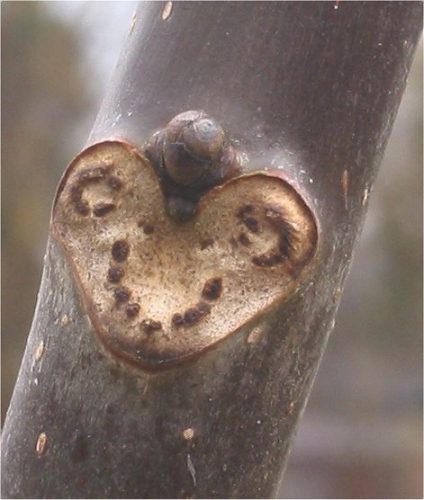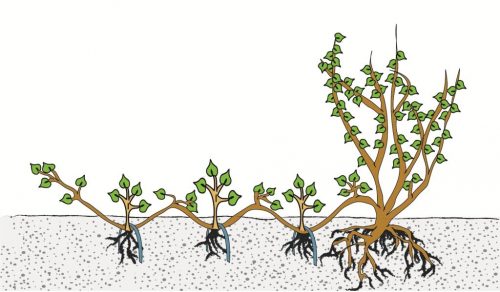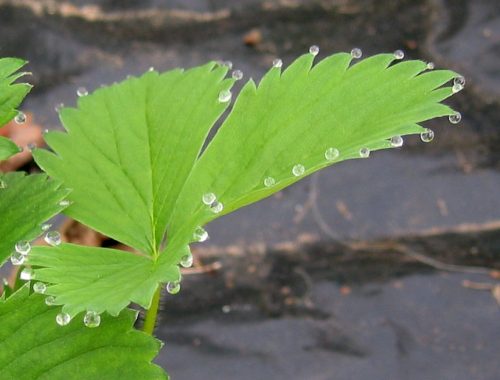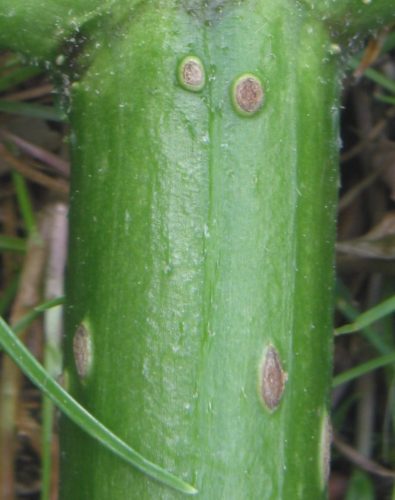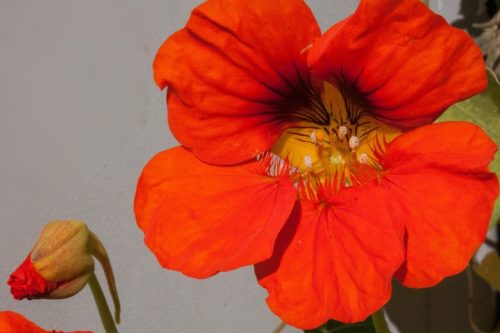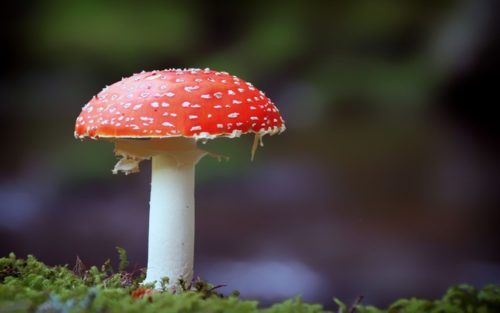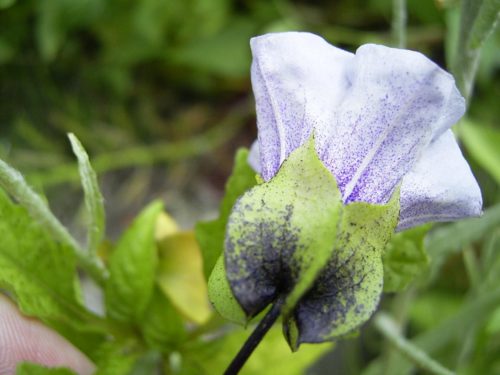Aggregate fruit – accessory fruits resemble fruits but are not from a botanical point of view. True fruits develop from the ovary and seed. If other plant parts are part of the fruit, it is called an aggregate fruit. See: Strawberry.
Armillaria root rot – rotting of roots of woody plants (mainly trees) by fungi of the genus Armillaria. Symptoms depend on the infected host, ranging from stunted leaves to yellowed needles and branch dieback.
Biopesticides – substances that kill harmful organisms; made from the natural enemies of these harmful organisms. See: Pesticides
Bolting/bolt – aka running to seed – a crop stops growing and puts all its energy into flowering and then into seed formation. As flowering and seed formation progress, roots and leaves lose their flavor and become tough.
Cut-and-come-again harvesting – cutting just a few leaves from each plant at a time. Taking leaves like this prolongs the cropping period and also produces more leaves. Cut or twist the leaves from the stem, taking care not to damage it and leave the central leaves untouched so these can grow on for the next cut.
Cucurbitacin – are toxic substances that occur in cucurbits such as the pumpkin and are intended to repel insects. Most ornamental gourds have high levels of cucurbitacin, making them poisonous.
Cultivar – is a plant that has been grown according to desirable characteristics (colour, size, etc.) and can be propagated (cuttings, grafting, seed) while maintaining the desired characteristics.
Delta pheromone trap – the delta trap has a triangular shape and consists of a base plate with non-drying glue and a ‘roof’ of durable, weather-resistant material. The male codling moths are attracted by the pheromones, land on the base plate and cannot leave.
Exotic – a plant or animal that has established itself in a country or continent from which it does not originate.
Forcing – the growth process is accelerated in such a way that it is possible to harvest earlier, see also file Forcing.
Green manure – crops that are not grown for human consumption, but to improve and fertilize the soil.
Guttation – if the weather is humid and a plant cannot evaporate enough moisture, with the result that water absorption and evaporation are no longer in balance, the plant ‘sweats out’ the excess moisture.
Host plant – is a plant (the host) on which an organism finds food necessary for growth. Insects, caterpillars, fungi and bacteria make use of host plants. See also file Host plant .
Hybrid – crossing resulting from sexual intercourse between two different species (plants or animals).
Invasive species – a plant or animal that has settled in a country or continent from which it does not originate. For example: rabbits in Australia.
Knotweed family (Polygonaceae) – mainly includes herbs, but also shrubs and trees. Buckwheat, rhubarb and sorrel are among them.
Layering – vegetative (asexual) propagation of a plant by laying a branch on the earth and covering it. Root growth occurs where the branch is in the soil. As soon as suckers appear on the discarded branch, loosen the cuttings from the plant. Examples: Forsythia, strawberry, fig.
Leaf scar – is the spot on the branch or trunk where the fallen leaf in the fall has been. Leaf scars are places where infections can easily enter.
Leaf wet period – the time (the number of hours) that a leaf is damp due to rain, fog or dew. Fungal spores can easily germinate on damp leaves.
Leaf wetness – In professional fruit cultivation, it is monitored how long the leaf remains wet. The longer infectable parts, such as leaves, fruits, shoots, remain wet, the greater the chance of infections. The degree of infection risk is a combination of the wet leaf period and the outside temperature.
Lenticel – a thin spot in the surface of tubers, roots, stems and trunk where the gas exchange (oxygen, carbon dioxide and water vapor) of the plant with the outside world takes place. Also called bark or cork pore. Gas exchange of leaves takes place through the stomata in the leaf.
Naturalized plants is the name of a group of plants that have become naturalized from once imported ornamental plants in country estates, farmyards and rectory gardens. These plants spread into the non-native environments and are able to reproduce in their new home, i.e. daffodils.
Natural poisons – small amounts of poison intended to keep insects at bay. Green, unripe tomatoes contain tomatine and the green parts of the potato solanine . Purslane, spinach and rhubarb contain oxalic acid . Cauliflower, broccoli and Brussels sprouts contain glucosinolates , the toxin that gives these vegetables their distinctive bitter taste. Green beans contain lectin .
Necrotrophic parasite – Parasite that kills the plant to continue living as a parasite on the dead wood.
Nitrates are nitrogen compounds. In the nitrogen cycle, plants absorb nitrogen from the soil in the form of nitrates. Beets, spinach, endive, radishes, celery and purslane, among others, are among the vegetables that can contain more than one gram (1000 mg) of nitrate per kilogram; see also file Nitrate, nitrite.
Nymph – young insect, the metamorphosis of which is not complete. The nymphs already resemble the adults, but are not yet.
Oxalic acid – weak acid that occurs naturally in many plants (including rhubarb); see also file Oxalic acid.
pH – measure of the acidity of an aqueous solution. A neutral aqueous solution has a pH of 7.
Primocane vs Floricane – varieties of blackberries and raspberries are floricane fruiting, or summer-bearing, which means they produce berries only on the second year growth, the floricanes. The fruit appears in early to midsummer. Primocane varieties are also known as fall-bearing or ever-bearing plants.
Pruning or pinching side shoots – removing unnecessary side branches that are superfluous or even hinder the growth of fruits (tomatoes, aubergine, peppers, cucumber and pumpkin).
Relative humidity – When the amount of water vapor remains the same and the temperature decreases, the relative humidity increases: the humidity indicates how much water vapor is present in the air compared to the maximum amount of water vapor that the air can contain: 100% is maximum humidity. If the humidity exceeds 100%, the excess water vapor condenses in the form of dew, fog or frost.
Rotational cultivation – annual plants that change places in successive years to prevent disease.
Serpentine and blotches mines – leafminers are classified by the pattern they create. Serpentine leaf mines trail snake-like across the leaf. Blotch leaf mines are irregularly shaped circles. Both serpentine and blotches arise because larva eat away at the leaf tissue when they penetrate the leaf. The leaf green has disappeared, the thin pale leaf skin and the veins remain behind.
Slime molds (Myxomycetes) are not fungi (mushrooms) nor do they belong to the plant and animal kingdom. A slime mold consists of an amalgamation of cells. The whole can move, leaving a slime trail.
Solanine – is a natural poison, which protects the potato from attackers. Solanine is formed in the skins and shoots of potatoes under the influence of light. Recognizable by the green spots on potatoes. Tomatoes may contain a related substance: tomatine . This only occurs in unripe (green) tomatoes. Both substances are toxic in large amounts.
Soralen – part of lichens consisting of loose tissues that coexist with algae and are intended for the vegetative reproduction of lichens.
Sprout vegetable – vegetable that is harvested and eaten when only two leaves are left on the seedling.
ssp – abbreviation of subspecies , subspecies. A species can have several subspecies.
Sunburn (Sunscald) – In days with tropical temperatures (> 30ºC) can burn apples, grapes and small fruit if they are hung in full sun. See also: Sunburn and drought damage.
Symbiosis – form of living together of two different kinds of organisms, in which both or one benefit. Birch life in symbiosis with soil fungi such as the fly agaric.
The Three Ice Men – May 11-15. After the Ice Saints, the chance of frost on the ground is very small, but can still occur.
Trap crop – lure away pest insects. Real trap crops are nasturtiums (attracts aphids, cabbage whites, white and carrot flies), marigolds (attracts carrot nema
Vegetative propagation – asexual reproduction by grafting, inoculation, shedding and tearing of root balls.
White rot – the lignin in the wood is broken down by fungi. Lignin together with cellulose forms wood. When lignin disappears, the tree loses strength because only cellulose remains. The tree becomes susceptible to trunk breakage. Not to be confused with white rot on members of the garlic family (leeks, chives, onion) (Sclerotium cepivorum)
Wound parasite – fungus that invades trees through leaf scars, damage and pruning wounds.
